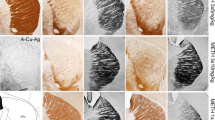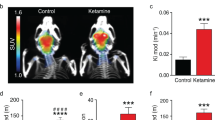Abstract
The amphetamine-related drug 3,4methylenedioxymethamphetamine (MDMA) is known to induce neurotoxic damage in dopaminergic regions of the mouse brain. In order to characterize how the number of administrations influenced the severity of MDMA-induced dopaminergic damage and to describe the localization and persistence of this damage, we evaluated the changes in tyrosine hydroxylase (TH) and dopamine transporter (DAT) in different regions of the mouse brain. Moreover, we investigated whether dopaminergic damage was associated with noradrenergic, GABAergic, and serotonergic damage, by evaluating the changes in noradrenaline transporter (NET), glutamic acid decarboxylase-67 (GAD-67), and serotonin transporter (SERT). Mice received 14, 28, or 36 MDMA administrations (10 mg/kg twice a week) and were sacrificed at different time points (postnatal days 85, 110, 138, or 214) for immunohistochemical evaluation. Mice receiving 28 administrations showed reduced levels of DAT-positive fibers in caudate–putamen (CPu) and medial prefrontal cortex (mPFC) and reduced levels of TH-positive nigral neurons. These mice also displayed increased NET-positive hippocampal fibers, reduced GAD-67-positive neurons in CPu and hippocampus, and reduced GAD-67-positive fibers in mPFC. Similar effects of MDMA on DAT, TH, and GAD-67 were found in mice receiving 36 administrations, which also displayed reduced levels of striatal, cortical, and hippocampal TH-immunoreactive fibers. The reductions in dopaminergic markers and GAD-67 persisted at 3 months after MDMA discontinuation. Finally, MDMA never modified the levels of SERT. These results provide further insight into the localization and persistence of MDMA-induced dopaminergic damage and show that this effect may associate with GABAergic but not noradrenergic or serotonergic damage.




Similar content being viewed by others

References
Abad S, Junyent F, Auladell C, Pubill D, Pallàs M, Camarasa J, Escubedo E, Camins A (2014) 3,4-Methylenedioxymethamphetamine enhances kainic acid convulsive susceptibility. Prog Neuro-Psychopharmacol Biol Psychiatry 54:231–242
Anneken JH, Cunningham JI, Collins SA, Yamamoto BK, Gudelsky GA (2013) MDMA increases glutamate release and reduces parvalbumin-positive GABAergic cells in the dorsal hippocampus of the rat: role of cyclooxygenase. J NeuroImmune Pharmacol 8:58–65
Barrett SP, Darredeau C, Pihl RO (2006) Patterns of simultaneous polysubstance use in drug using university students. Hum Psychopharmacol 21:255–263
Baumann MH, Wang X, Rothman RB (2007) 3,4-Methylenedioxymethamphetamine (MDMA) neurotoxicity in rats: a reappraisal of past and present findings. Psychopharmacology 189:407–424
Bentivoglio M, Morelli M (2005) The organization and circuits of mesencephalic dopaminergic neurons and the distribution of dopamine receptors in the brain. In: Dunnett SB, Bentivoglio M, Björklund A, Hökfelt T (eds) Handbook of chemical neuroanatomy. Elsevier, Amsterdam, pp 1–10
Cadet JL, Krasnova IN, Jayanthi S, Lyles J (2007) Neurotoxicity of substituted amphetamines: molecular and cellular mechanisms. Neurotox res 11:183–202
Callaghan RC, Cunningham JK, Sykes J, Kish SJ (2012) Increased risk of Parkinson’s disease in individuals hospitalized with conditions related to the use of methamphetamine or other amphetamine-type drugs. Drug Alcohol Depend 120:35–40
Camarero J, Sanchez V, O’Shea E, Green AR, Colado MI (2002) Studies, using in vivo microdialysis, on the effect of the dopamine uptake inhibitor GBR 12909 on 3,4-methylenedioxymethamphetamine (‘ecstasy’)-induced dopamine release and free radical formation in the mouse CPu. J Neurochem 81:961–972
Clemens KJ, Cornish JL, Hunt GE, McGregor IS (2007) Repeated weekly exposure to MDMA, methamphetamine or their combination: long-term behavioural and neurochemical effects in rats. Drug Alcohol Depend 86:183–190
Colado MI, Camarero J, Mechan AO, Sanchez V, Esteban B, Elliott JM, Green AR (2001) A study of the mechanisms involved in the neurotoxic action of 3,4-methylenedioxymethamphetamine (MDMA, ‘ecstasy’) on dopamine neurones in mouse brain. Br J Pharmacol 134:1711–1723
Colado MI, O’Shea E, Green AR (2004) Acute and long-term effects of MDMA on cerebral dopamine biochemistry and function. Psychopharmacology 173:249–263
Cole JC, Sumnall HR (2003) The pre-clinical behavioural pharmacology of 3,4-methylenedioxymethamphetamine (MDMA). Neurosci Biobehav rev 27:199–217
Commins DL, Vosmer G, Virus RM, Woolverton WL, Schuster CR, Seiden LS (1987) Biochemical and histological evidence that methylenedioxymethamphetamine is toxic to neurons in the rat brain. J Pharmacol Exp Ther 241:338–345
Costa G, Frau L, Wardas J, Pinna A, Plumitallo A, Morelli M (2013) MPTP-induced dopamine neuron degeneration and glia activation is potentiated in MDMA-pretreated mice. Mov Disord 28:1957–1965
Costa G, Simola N, Morelli M (2014) MDMA administration during adolescence exacerbates MPTP-induced cognitive impairment and neuroinflammation in the hippocampus and prefrontal cortex. Psychopharmacology 231:4007–4018
Costa G, Morelli M, Simola N (2016) Methylxanthines and drug dependence: interactions and toxicity. In: Preedy VR (ed) Neuropathology of drug addictions and substance misuse, volume 3. Elsevier, Amsterdam, pp 912–923
Curtin K, Fleckenstein AE, Robison RJ, Crookston MJ, Smith KR, Hanson GR (2015) Methamphetamine/amphetamine abuse and risk of Parkinson’s disease in Utah: a population-based assessment. Drug Alcohol Depend 146:30–38
Easton N, Marsden CA (2006) Ecstasy: are animal data consistent between species and can they translate to humans? J Psychopharmacol 20:194–210
Frau L, Simola N, Plumitallo A, Morelli M (2013) Microglial and astroglial activation by 3,4-methylenedioxymethamphetamine (MDMA) in mice depends on S(+) enantiomer and is associated with an increase in body temperature and motility. J Neurochem 124:69–78
Frau L, Simola N, Porceddu PF, Morelli M (2016) Effect of crowding, temperature and age on glia activation and dopaminergic neurotoxicity induced by MDMA in the mouse brain. Neurotoxicology 56:127–138
Garwood ER, Bekele W, McCulloch CE, Christine CW (2006) Amphetamine exposure is elevated in Parkinson’s disease. Neurotoxicology 27:1003–1006
Gerra G, Zaimovic A, Moi G, Giusti F, Gardini S, Delsignore R, Laviola G, Macchia T, Brambilla F (2002) Effects of (+/−) 3,4-methylene-dioxymethamphetamine (ecstasy) on dopamine system function in humans. Behav Brain res 134:403–410
Górska AM, Noworyta-Sokołowska K, Gołembiowska K (2014) The effect of caffeine on MDMA-induced hydroxyl radical production in the mouse striatum. Pharmacol rep 66:718–721
Granado N, O’Shea E, Bove J, Vila M, Colado MI, Moratalla R (2008) Persistent MDMA-induced dopaminergic neurotoxicity in the CPu and substantia nigra of mice. J Neurochem 107:1102–1112
Green AR, Mechan AO, Elliott JM, O’Shea E, Colado MI (2003) The pharmacology and clinical pharmacology of 3,4-methylenedioxymethamphetamine (MDMA, “ecstasy”). Pharmacol rev 55:463–508
Gudelsky GA, Nash JF (1996) Carrier-mediated release of serotonin by 3,4-methylenedioxymethamphetamine: implications for serotonin–dopamine interactions. J Neurochem 66:243–249
Gudelsky GA, Yamamoto BK (2008) Actions of 3,4-methylenedioxymethamphetamine (MDMA) on cerebral dopaminergic, serotonergic and cholinergic neurons. Pharmacol Biochem Behav 90:198–207
Hagino Y, Takamatsu Y, Yamamoto H, Iwamura T, Murphy DL, Uhl GR, Sora I, Ikeda K (2011) Effects of MDMA on extracellular dopamine and serotonin levels in mice lacking dopamine and/or serotonin transporters. Curr Neuropharmacol 9:91–95
Halpin LE, Collins SA, Yamamoto BK (2014) Neurotoxicity of methamphetamine and 3,4-methylenedioxymethamphetamine. Life Sci 97:37–44
Huff CL, Morano RL, Herman JP, Yamamoto BK, Gudelsky GA (2016) MDMA decreases glutamic acid decarboxylase (GAD) 67-immunoreactive neurons in the hippocampus and increases seizure susceptibility: role for glutamate. Neurotoxicology 57:282–290
Hysek CM, Simmler LD, Ineichen M, Grouzmann E, Hoener MC, Brenneisen R, Huwyler J, Liechti ME (2011) The norepinephrine transporter inhibitor reboxetine reduces stimulant effects of MDMA (“ecstasy”) in humans. Clin Pharmacol Ther 90:246–255
Iravani MM, Asari D, Patel J, Wieczorek WJ, Kruk ZL (2000) Direct effects of 3,4-methylenedioxymethamphetamine (MDMA) on serotonin or dopamine release and uptake in the caudate putamen, nucleus accumbens, substantia nigra pars reticulata, and the dorsal raphe nucleus slices. Synapse 36:275–285
Izco M, Marchant I, Escobedo I, Peraile I, Delgado M, Higuera-Matas A, Olias O, Ambrosio E, O’Shea E, Colado MI (2007) Mice with decreased cerebral dopamine function following a neurotoxic dose of MDMA (3,4-methylenedioxymethamphetamine, “ecstasy”) exhibit increased ethanol consumption and preference. J Pharmacol Exp Ther 322:1003–1012
Jakowec MW, Nixon K, Hogg E, McNeill T, Petzinger GM (2004) Tyrosine hydroxylase and dopamine transporter expression following 1-methyl-4-phenyl-1,2,3,6-tetrahydropyridine-induced neurodegeneration of the mouse nigrostriatal pathway. J Neurosci res 76:539–550
Jansen KL (1999) Ecstasy (MDMA) dependence. Drug Alcohol Depend 53:121–124
Kawaguchi Y, Wilson CJ, Augood SJ, Emson PC (1995) Striatal interneurons: chemical, physiological and morphological characterization. Trends Neurosci 18:527–535
Kish SJ, Furukawa Y, Ang L, Vorce SP, Kalasinsky KS (2000) Striatal serotonin is depleted in brain of a human MDMA (ecstasy) user. Neurology 55:294–296
Laprade N, Soghomonian JJ (1995) Differential regulation of mRNA levels encoding for the two isoforms of glutamate decarboxylase (GAD65 and GAD67) by dopamine receptors in the rat CPu. Mol Brain res 34:65–74
Lindefors N (1993) Dopaminergic regulation of glutamic acid decarboxylase mRNA expression and GABA release in the CPu: a review. Prog Neuro-Psychopharmacol Biol Psychiatry 17:887–903
McCann UD, Ricaurte GA (2001) Caveat emptor: editors beware. Neuropsychopharmacology 24:333–336
McCann UD, Ridenour A, Shaham Y, Ricaurte GA (1994) Serotonin neurotoxicity after(+/−)3,4-methylenedioxymethamphetamine (MDMA; “ecstasy”): a controlled study in humans. Neuropsychopharmacology 10:129–138
McCann UD, Szabo Z, Scheffel U, Dannals RF, Ricaurte GA (1998) Positron emission tomographic evidence of toxic effect of MDMA (“ecstasy”) on brain serotonin neurons in human beings. Lancet 352:1433–1437
McCann UD, Eligulashvili V, Ricaurte GA (2000) (+/−)3,4-Methylenedioxymethamphetamine (‘ecstasy’)-induced serotonin neurotoxicity: clinical studies. Neuropsychobiology 42:11–16
McNamara R, Kerans A, O’Neill B, Harkin A (2006) Caffeine promotes hyperthermia and serotonergic loss following co-administration of the substituted amphetamines, MDMA (“ecstasy”) and MDA (“love”). Neuropharmacology 50:69–80
Moratalla R, Khairnar A, Simola N, Granado N, García-Montes JR, Porceddu PF, Tizabi Y, Costa G, Morelli M (2015) Amphetamine-related drugs neurotoxicity in humans and in experimental animals: main mechanisms. Prog Neurobiol Pii S0301-0082(15):00100–00108
Parrott AC (2001) Human psychopharmacology of ecstasy (MDMA): a review of 15 years of empirical research. Hum Psychopharmacol 16:557–577
Parrott AC (2005) Chronic tolerance to recreational MDMA (3,4-methylenedioxymethamphetamine) or ecstasy. J Psychopharmacol 19:71–83
Parrott AC (2012) MDMA and 5-HT neurotoxicity: the empirical evidence for its adverse effects in humans—no need for translation. Br J Pharmacol 166:1518–1520 discussion 1521-1522
Paxinos G, Franklin KBJ (2008) The mouse brain in stereotaxic coordinates, third edn. Academic Press, San Diego
Ricaurte GA, McCann UD (1992) Neurotoxic amphetamine analogues: effects in monkeys and implications for humans. Ann N Y Acad Sci 648:371–382
Ricaurte GA, DeLanney LE, Irwin I, Langston JW (1988) Toxic effects of MDMA on central serotonergic neurons in the primate: importance of route and frequency of drug administration. Brain res 446:165–168
Ros-Simó C, Ruiz-Medina J, Valverde O (2012) Behavioural and neuroinflammatory effects of the combination of binge ethanol and MDMA in mice. Psychopharmacology 221:511–525
Saadat KS, Elliott JM, Colado MI, Green AR (2004) Hyperthermic and neurotoxic effect of 3,4-methylenedioxymethamphetamine (MDMA) in guinea pigs. Psychopharmacology 173:452–453
Séguéla P, Watkins KC, Geffard M, Descarries L (1990) Noradrenaline axon terminals in adult rat neocortex: an immunocytochemical analysis in serial thin sections. Neuroscience 35:249–264
Stone DM, Hanson GR, Gibb JW (1987) Differences in the central serotonergic effects of methylenedioxymethamphetamine (MDMA) in mice and rats. Neuropharmacology 26:1657–1661
Stone DM, Hanson GR, Gibb JW (1989) In vitro reactivation of rat cortical tryptophan hydroxylase following in vivo inactivation by methylenedioxymethamphetamine. J Neurochem 53:572–581
Strote J, Lee JE, Wechsler H (2002) Increasing MDMA use among college students: results of a national survey. J Adolesc Health 30:64–72
Tai YF, Hoshi R, Brignell CM, Cohen L, Brooks DJ, Curran HV, Piccini P (2011) Persistent nigrostriatal dopaminergic abnormalities in ex-users of MDMA (‘ecstasy’): an 18F-dopa PET study. Neuropsychopharmacology 36:735–743
Verrico CD, Miller GM, Madras BK (2007) MDMA (ecstasy) and human dopamine, norepinephrine, and serotonin transporters: implications for MDMA-induced neurotoxicity and treatment. Psychopharmacology 189:489–503
Wichmann T, Delong MR (2007) Anatomy and physiology of the basal ganglia: relevance to Parkinson’s disease and related disorders. Handb Clin Neurol 83:1–18
Acknowledgments
This study was supported by funds from Regione Autonoma della Sardegna (Legge Regionale 7 Agosto 2007, N.7, annualità 2008 and 2010). Dr. Giulia Costa gratefully acknowledges the University of Cagliari for financial support (D.R. n.159 del 18.11.2016). The authors are grateful to Prof. Antonio Plumitallo for the synthesis of MDMA.
Author information
Authors and Affiliations
Corresponding author
Ethics declarations
Conflict of Interest
The authors declare that there are no conflicts of interest.
Rights and permissions
About this article
Cite this article
Costa, G., Morelli, M. & Simola, N. Progression and Persistence of Neurotoxicity Induced by MDMA in Dopaminergic Regions of the Mouse Brain and Association with Noradrenergic, GABAergic, and Serotonergic Damage. Neurotox Res 32, 563–574 (2017). https://doi.org/10.1007/s12640-017-9761-6
Received:
Revised:
Accepted:
Published:
Issue Date:
DOI: https://doi.org/10.1007/s12640-017-9761-6



